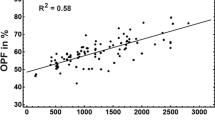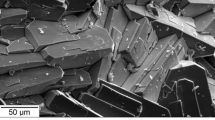Abstract
1-4-diazabicyclo[2,2,2]octane dihydrochloride (DABCO-2HC1) was reacted with two vermic-ulite samples to produce intercalates which, at room temperature, had relatively sharp, single crystal X-ray diffraction patterns. At higher temperatures (250°C) the stacking order decreased, and consequently the Okl reflections with k ≠= 3n became increasingly diffuse. The stacking order of previously heated samples returned when they were cooled. A superstructure was present in which DABCO cations occupied the corners and center of a cell 3a × b, compared with the standard vermiculite cell.
DABCO-intercalated Nyasaland vermiculite had the following monoclinic subcell (symmetry CI) parameters under ambient conditions: a = 5.341(2), b = 9.249(3), c = 14.50(1) Å, and ß = 96.98(5)°. Differential Fourier analyses and least-squares refinement led to a final R value of 12.6% for 1814 reflections. The crystal structure analysis showed that individual DABCO ions were not symmetrically positioned between the silicate layers. A network of inorganic cations and water molecules was also present and governed the interlayer separation. At 250°C the d value was 13.7 Å, consistent with a dehydrated structure, in which each organic pillar has one amino group keyed into a ditrigonal cavity and the other amino group riding on the basal oxygens of an opposite tetrahedron.
Similar content being viewed by others
References
Alcover, J. F., Gatineau, L., and Méring, J. (1973) Exchangeable cation distribution in nickel and magnesium vermiculite: Clays & Clay Minerals 21, 131–136.
de la Calle, C. (1977) Structures des vermiculites. Facteurs conditionnant les mouvements de feuillets: Thésis, Université P. et M. Curie, Paris, 136 pp.
de la Calle, C., Dubernat, J., Suquet, H., Pezerat, H., Gaultier, J., and Mamy, J. (1976) Crystal structure of two-layer Mg-vermiculite and Na, Cavermiculites: in Proc. Int. Clay Conf, Mexico City, 1975, S. W. Bailey, ed., Applied Publishing, Wilmette, Illinois, 201–209.
International Tables for X-ray Crystallography (1974) Vol. IV, Kynoch Press, Birmingham, United Kingdom, 99–101, 1490–150.
Kennedy, S. W., Schultz, P. K., Slade, P. G., and Tiekink, E. R. T. (1987) Crystal structure of triethylenediamine di-hydrochloride: Z. Kristallogr. 180, 211–217.
MacEwan, D. M. C. and Wilson, M. J. (1980) Interlayer and intercalation complexes of clay minerals: in Crystal Structures of Clay Minerals and their X-ray Identification, G. W. Brindley and G. Brown, eds., Mineralogical Society, London, p. 203.
Motherwell, W. D. S. (1978) PLUTO 78. A plotting program for Cambridge crystallographic data: Chemical Laboratory, Cambridge Univ., Cambridge, United Kingdom, 26 pp.
Shabtai, J., Frydman, N., and Lazar, R. (1977) Synthesis and catalytic properties of a 1,4-diazabicyclo(2,2,2) octane-montmorillonite system—A novel type of molecular sieve: in Proc. Int. Cong. Catal, London, 1976, G. C. Bond, P. B. Wells, and F. C. Tompkins, eds., Chem. Soc, London, 660–667.
Sheldrick, G. M. (1976) SHELX 76. Program for crystal structure determination: Cambridge Univ., Cambridge, United Kingdom, 150 pp.
Shirozu, J. and Bailey, S. W. (1966) Crystal structure of a two layer Mg-vermiculite: Amer. Mineral. 52, 1124–1143.
Slade, P. G., Dean, C., Schultz, P. K., and Self, P. G. (1987) Crystal structure of a vermiculite-anilinium intercalate: Clays & Clay Minerals is, 177–188.
Slade, P. G., Raupach, M., and Emerson, W. W. (1978) The ordering of cetylpyridinium bromide on vermiculite: Clays & Clay Minerals 26, 125–134.
Slade, P. G. and Raupach, M. (1982) Structural model for benzidine-vermiculite: Clays & Clay Minerals 30,297-305.
Slade, P. G. and Stone, P. A. (1983) Structure of a vermic-ulite-aniline intercalate: Clays & Clay Minerals 31, 200–206.
Slade, P. G. and Stone, P. A. (1984) Three-dimensional order and the structure of aniline-vermiculite: Clays & Clay Minerals 32, 223–226.
Slade, P. G., Stone, P. A., and Radoslovich, E. W. (1985) Interlayer structures of the two-layer hydrates of Na- and Ca-vermiculites: Clays & Clay Minerals 33, 51–61.
Terrin, D. D. (1965) Dissociation Constants of Organic Bases in Aqueous Solutions: Butterworths, London, p. 285.
Thompson, J. G. (1984) 29Si and27Al nuclear magnetic resonance spectroscopy of 2:1 clay minerals: Clay Miner. 19, 229–236.
Tokonami, M. (1965) Atomic scattering factor for O7: Acta Crystallogr. 19, p. 486.
Author information
Authors and Affiliations
Rights and permissions
About this article
Cite this article
Slade, P.G., Schultz, P.K. & Tiekink, E.R.T. Structure of a 1,4-Diazabicyclo[2,2,2]Octane-Vermiculite Intercalate. Clays Clay Miner. 37, 81–88 (1989). https://doi.org/10.1346/CCMN.1989.0370110
Received:
Accepted:
Published:
Issue Date:
DOI: https://doi.org/10.1346/CCMN.1989.0370110




